Club History and Past Officers
(See Breed History Below)
American Spaniel Club Officers 1881-2018 (Click to view)
Founded in 1881, the American Spaniel Club (ASC) is the first club devoted to one breed of dogs in the United States and possibly, the world. The breed is the Cocker Spaniel and the club has been respected in the dog world both in the show ring, field, performance events and most particularly –at home with the family.
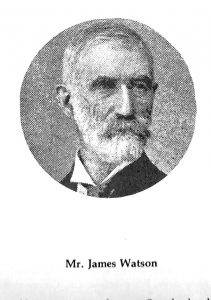 Originally named The American Cocker Spaniel Club, the organizational committee included D. J.L. Morrill, Chair, James Watson (1881 picture to the left) and A. McCollom. A. H. Moore from Philadelphia was elected as the first president in February 1881 with George D. Macdougall of Whitestone, Long Island, New York, the first secretary .
Originally named The American Cocker Spaniel Club, the organizational committee included D. J.L. Morrill, Chair, James Watson (1881 picture to the left) and A. McCollom. A. H. Moore from Philadelphia was elected as the first president in February 1881 with George D. Macdougall of Whitestone, Long Island, New York, the first secretary .
A. Clinton Wilmerding (picture right below) was a charter member together with James Watson, George D. Macdougall, (NY), Dr. J.S. Niven, (London, Ontario), J. Otis Fellows (Hornellsville), M.P. McKoon, (Upstate NY), A.E. Goddefroy, (Guymard, Orange Co.), Dr. J.S. Catanack, (NY), Dr. J L. Merrill, A. McCollom, A. H. Moore, (Philadelphia), E. Tinsley, (Hamilton, Ontario), C. B. Cummings, J. H. Whitman, and J. F. Kirk, (Toronto).
For decades, spaniel breeds were sorted by weight. If a dog weighed 28 pounds or more, it was a Field or Springer Spaniel. If less, it was a Cocker Spaniel and scales were kept ringside at shows like wickets are today for measuring height. By 1908 the now American Spaniel Club established breed standards to better define what made a Cocker a Cocker and not a Field or Springer Spaniel. (link to first Cocker Spaniel breed standard)
As popularity of the Cocker grew in the 1930’s and 1940’s a wave of interest grew in the other spaniel breeds. And as all spaniel breed numbers increased, ASC leadership recognized it could not do “full and equal justice to them all” and ASC worked with AKC to “transfer jurisdiction over all breeds of sporting spaniels other than Cocker Spaniels to clubs to be organized as parent clubs dedicated to the furtherance of the fortunes of these several breeds of sporting spaniels.” The first to fledge from the ASC nest was the English Springer Spaniel and ASC transferred responsibility to the newly formed English Springer Spaniel Field Trial Association, Inc. with the condition ASC could offer classes for ESS at the American Spaniel Club’s specialty shows. Today that event is the American Spaniel Club Flushing Spaniel Show held annually in January.
The resolution was: RESOLUTION: “In consideration of approval by the American Kennel Club (without requiring permission of any specialty club) of classes for all breeds of sporting spaniels at specialty shows of the American Spaniel Club, the latter relinquishes all jurisdiction as parent club of any breed, except Cocker Spaniels. It is mutually understood that the breed recognized as a Brittany Spaniel is a setter and not a spaniel and therefore is not included among breeds of sporting spaniels.”
Another change negotiated during this transfer was the addition of “solid colored Cocker Spaniels other than black (ASCOB) that included black and tans: as a separate variety. This gave Cocker Spaniels four varieties in the Sporting Group—Black, ASCOB, Parti-Color and English type. In time black and tans were moved to the Black Variety where they are shown today. An interesting note is the first Cockers shown in the U.S. in 1875 were black and tans.
In 1943 ASC established a national Standards Committee to evaluate the current standard. They worked to clarify the written standard for color and markings in Cocker Spaniels as a “starting point” for the future of the breed. Their recommendations were approved with two changes–the percentage of solid color in a parti-colored, and substituting “penalty” for “disqualification” for Cockers under 22 pounds or over 28.
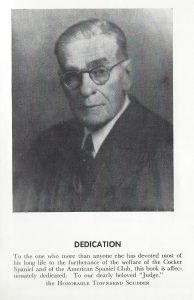 In June 1946, the English Cocker Spaniel was recognized as a separate breed from the Cocker Spaniel. ASC President Townsend Scudder (photo above) noted in his annual address that “through sympathetic understanding and appreciation of conditions by the American Kennel Club, the English Cocker Spaniel was recognized as a distinct type of Cocker Spaniel” and separate classes were established for it with a place in the Group ring. Parti-color Cocker Spaniels were also admitted to the Sporting Group as a separate type of Cocker Spaniel.
In June 1946, the English Cocker Spaniel was recognized as a separate breed from the Cocker Spaniel. ASC President Townsend Scudder (photo above) noted in his annual address that “through sympathetic understanding and appreciation of conditions by the American Kennel Club, the English Cocker Spaniel was recognized as a distinct type of Cocker Spaniel” and separate classes were established for it with a place in the Group ring. Parti-color Cocker Spaniels were also admitted to the Sporting Group as a separate type of Cocker Spaniel.
Popularity of the Cocker Spaniel continued to grow and ASC felt it was important to create ways to engage these new owners. Only a few years earlier, membership was at 65. By 1945, there were 400, double from two years earlier and there were 21 regional Cocker Spaniel Specialty Clubs in 1946. To meet this growing interest club leadership established four regional membership zones in the U.S.
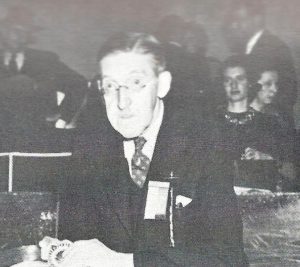 Then President S. Y. L’Hommedieu (photo to left) wrote, “Up to the early twenties the club enjoyed a normal club existence. The membership was comparatively small but was made up of a group of people who took their club seriously and all worked together to send it on its way in a manner which shows up in the prosperous and healthy club it is today.”
Then President S. Y. L’Hommedieu (photo to left) wrote, “Up to the early twenties the club enjoyed a normal club existence. The membership was comparatively small but was made up of a group of people who took their club seriously and all worked together to send it on its way in a manner which shows up in the prosperous and healthy club it is today.”
Cocker Spaniels topped the AKC registration list in 1947 and dedicated breeders began to worry about the impact of such popularity on the overall quality of the breed. Dog people had seen what happens to a breed cast into the limelight because that very demand attracts many types of breeders. Many not committed to the work needed to “build the breed up. Newer people were attracted by commercial profit with little interest in breeding as a study. As quality is diminished, popularity falls until commercial breeders look for the next big thing. By 1954 the anticipated drop off in registrations was apparent in a drop in AKC registrations by one third.
Looking to cultivate the former interest in Cockers as a gun dog, Henry Berol replaced Ralph Craig (1955 photo below to right) in 1951 as Field 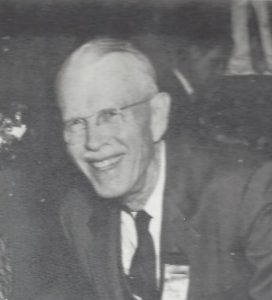 Committee Chair and worked to establish a National Championship Field Trial for Cocker Spaniels. During this time the Standards Committee recommended the standard be revised to replace a weight limit with a height restriction. The result was the maximum height for a Cocker was set at 15 ½ inches at the withers with 15 inches being ideal. For females the ideal was 14 inches.
Committee Chair and worked to establish a National Championship Field Trial for Cocker Spaniels. During this time the Standards Committee recommended the standard be revised to replace a weight limit with a height restriction. The result was the maximum height for a Cocker was set at 15 ½ inches at the withers with 15 inches being ideal. For females the ideal was 14 inches.
In 1952 Cocker specialty shows were held in every ASC Zone and there was a flurry of Cockers who earned their AKC Obedience titles. Berol’s efforts were successful and for the first time in 70 years, ASC held an AKC Licensed Cocker Spaniel National Championship Field Trial at Herrin, IL.
On December 12, 1953, A. Clinton Wilmerding passed on. He was the last living charter member and a faithful supporter of Cocker Spaniels and the club throughout his life.
The fortunes of ASC and Cocker Spaniels waxed and waned until the mid-‘80’s when Cockers again moved to the top of the AKC registration rankings with an explosion of activity. Once more field work was in view when ASC’s Working Dog program established by the efforts of Frank and Dee Dee Woods .
In 1997, ASC leadership established the American Spaniel Club Foundation, Inc., a 501(c)(3) non-profit charity organization dedicated to Cocker Spaniel health, research and rescue. The Organizational Board meeting was held July 20, 1998, in Ontario, California. The original Board of Directors included Louise Milner, Deborah Bowman and Marilyn Pryor with officers Louise Milner, President, Deborah Bowman, Vice-President, and Robert Clement, Secretary and Treasurer.
By 2000, all purebred dog clubs faced new challenges and these all affected ASC. Memberships stalled and dropped as older people passed on. The number of Cocker Spaniels registered each year fell by thousands and this changed environment required different ways of thinking with new tools and creative outreach. Performance competitions, often open to all breeds, were offered at national events to both provide ways for members to enjoy their dogs beyond the show ring and to help raise revenues to offset the cost of these events. AKC Hunt tests and hunting workshops gave many an owner a sense of the Cocker gundog heritage and the comprehensive, versatile Cocker Spaniel came into view.
In 2009 former ASC President Charles Born spoke to this new world in his final address to the membership. He suggested that friendship and community built around Cocker Spaniels can move us beyond our differences especially as the “world gets smaller and as our issues and problems are shared, and legislation and special interest groups become more influential in our sport”. Those shared values, he said, “are supported by friendships and associations”. “You see,” he said, “winning is fleeting. Oh sure, we all love a great dog show win, but that euphoria isn’t lasting – I suggest to you that friendships are. “
Specialized references used in writing this article:
- Kolehouse, Bobbie Lee S., Dusting Off History to Look at Cocker Hunting Tradition.”Spaniel Journal. 2003. http://www.spanieljournal.com/2bkolehouse.html
- The American Spaniel Club, The American Spaniel Club. 1959. Baldwin, New York.
- Wilmerding image – photo credit, All Spaniels, Their Breeding, Reading and Training by Freeman Lloyd, 1930.
- Watson image – photo credit – ASC Historical Archives, published in A Century of Spaniel, The American Spaniel Club 1881 – 1981, 1980 publication
- L’Hommediu, Craig and Scudder images – photo credit ASC Annual 1959
Breed History
THE ORIGIN OF THE COCKER SPANIEL and THE AMERICAN SPANIEL CLUB by Elaine E. Mathis
Photo Donated to ASC Archives by Carol Rutherford

Spaniels in America can be traced back to 1620 and the landing of the Mayflower. This vessel carried two dogs on her voyage to New England, a Mastiff and a Spaniel. However, it is impossible to trace the ancestry of the blooded dogs of today to these two dogs since pedigrees and stud books were not available prior to the early nineteenth century.
In those early days, the Spaniels were divided into two varieties, land and the water spaniels, and from those early specimens have sprung the many varieties of spaniels we have today, including the toys. After that, the terms Springer, Springing Spaniel, Cocker, Cocking Spaniel, Field, English Type, etc. seem to have applied to Spaniels of all sizes and the division we have today in the Spaniel family developed from that period. Another bit of history was that since the spaniels all derived from the same bloodlines and litters, the top weight limit of 28 lbs. was the dividing line between the cocker spaniel and the field spaniel, for the ones over 28 lbs. were adjudged a field spaniel. The term “Cocker” was given to the smallest, more compact of this family and it came about because they were being used for woodcock shooting.
Cocker registrations can be traced to 1879. The first Cocker strain to become well known and to make definite strides toward the Cocker’s recognition as a separate and distinct breed in England, was the “Obo” kennel of Mr. James Farrow. The National American Kennel Club (now the present American Kennel Club) published their first stud book in St. Louis Missouri. The very first Cocker registered was a liver and white named Captain and assigned No. 1354. The first black and tan registered was Jockey, No. 1365. Not until Volume 2 was published in 1885 did a black cocker make his appearance. This was registered as Brush II, No. 3124 and was imported by Commings Cocker Spaniel Kennel of Asworth, New Hampshire.
It was about this time that the founders of the American Spaniel Club were becoming actively interested in the dog that characterized as a Cocker, but not yet recognized as an entirely separate breed of Sporting Spaniel.
 The American Spaniel Club is the parent club of the Cocker Spaniel and was established in 1881. When the American Spaniel Club joined the American Kennel Club, which the American Spaniel Club antedated by several years, it was accepted and thereafter recognized as the parent club of sporting spaniels, a role and responsibility it assumed.
The American Spaniel Club is the parent club of the Cocker Spaniel and was established in 1881. When the American Spaniel Club joined the American Kennel Club, which the American Spaniel Club antedated by several years, it was accepted and thereafter recognized as the parent club of sporting spaniels, a role and responsibility it assumed.
The American Kennel Club recognized the separation of the “cocker” breed in September 1946, but it was not until January 1947 that breed registration appeared in the stud book under their own heading.
With time the popularity of the Cocker Spaniel increased by leaps and bounds, and sporting spaniels of other breeds becoming better known, spaniels rapidly grew in favor. With the increase in the number of breeders of Cocker Spaniels and of other breeds of sporting spaniels, the American Spaniel Club recognized its inability to do full and equal justice to all of them. The English Springer Spaniel was the first to crowd the parent club’s nest, and this emphasized the propriety of the American Spaniel Club surrendering and transferring its jurisdiction over English Springer Spaniels to a new club organization qualified to assume the responsibility of parenthood for the English Springer Spaniel. Through the good offices of the American Kennel Club, this happy result was brought about, and by mutual consent the English Springer Spaniel passed to the jurisdiction of the English Springer Spaniel Field Trial Association, Incorporated. The popularity of the Cocker Spaniel ever increasing, coupled with the introduction and winning favor of the English Type of Cocker Spaniel, again invited a change in the rules governing Sporting Spaniels. Once more, through the sympathetic understanding and appreciation of conditions by the American Kennel Club, the English Cocker Spaniel was recognized as a distinct type of Cocker Spaniel, separate classes were set up for it, and in due time it was deservedly admitted to the Sporting Group. 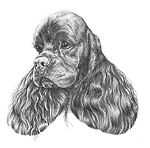 Negotiations were opened with the American Kennel Club to affect a transfer of jurisdiction over all breeds of sporting spaniels other than Cocker Spaniels to clubs to be organized as parent clubs dedicated to the furtherance of these several breeds of sporting spaniels. The American Kennel Club approving and consenting this was brought about, the American Spaniel Club retaining its right without consultation or permission of any Specialty Club to offer classes for all breeds of sporting spaniels at its American Spaniel Club Specialty Show.The American Spaniel Club stands out today, of all the specialty clubs in this country, and perhaps including the Old World as well, the first and original club devoted to one breed of dogs, with steady devotion to the sporting spaniel.
Negotiations were opened with the American Kennel Club to affect a transfer of jurisdiction over all breeds of sporting spaniels other than Cocker Spaniels to clubs to be organized as parent clubs dedicated to the furtherance of these several breeds of sporting spaniels. The American Kennel Club approving and consenting this was brought about, the American Spaniel Club retaining its right without consultation or permission of any Specialty Club to offer classes for all breeds of sporting spaniels at its American Spaniel Club Specialty Show.The American Spaniel Club stands out today, of all the specialty clubs in this country, and perhaps including the Old World as well, the first and original club devoted to one breed of dogs, with steady devotion to the sporting spaniel.
The popularity of the Sporting Spaniel is established for all time, and the smallest, the Cocker Spaniel, inherent desire to hunt renders him a capable gun dog when judiciously trained. The usual method of hunting is to let him qua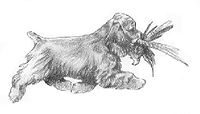 rter the ground ahead of the gun, covering all territory within gun range. This he should do at a fast, snappy pace. Upon flushing the game he should stop or preferable drop to a sitting position so as not to interfere with the shot, after which he should retrieve on command only. He should of course, be so trained that he will be under control at all times. He is likewise valuable for occasional water retrieving and as a rule takes to water readily.
rter the ground ahead of the gun, covering all territory within gun range. This he should do at a fast, snappy pace. Upon flushing the game he should stop or preferable drop to a sitting position so as not to interfere with the shot, after which he should retrieve on command only. He should of course, be so trained that he will be under control at all times. He is likewise valuable for occasional water retrieving and as a rule takes to water readily.
The breed is excellent in Breed, Obedience and Field work, with many having dual and triple titles. As a pet and companion his popularity has been exceptional. He is a great lover of home and family, trustworthy and adaptable.
References for this article:
Complete Dog Book – American Kennel Club
American Spaniel Club Annual Reports
Cocker Spaniel – Ruth Kraeuchi
